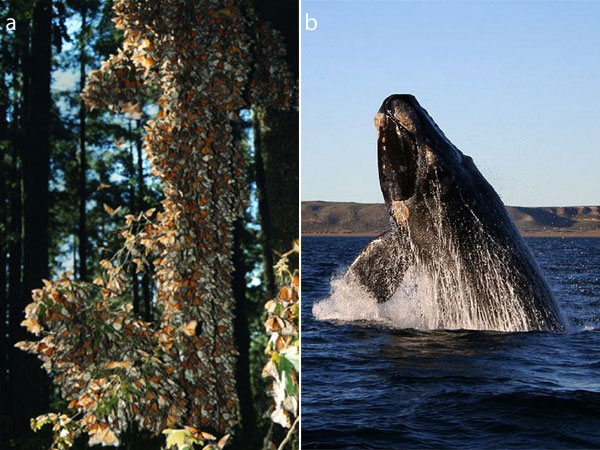Migrating animals are found in all major branches of the animal kingdom. They include taxa as diverse as fish, crustaceans, amphibians, reptiles, insects, mammals and slime moulds (Bowlin et al. 2010). The distance covered during some of the journeys, and the altitude at which they can take place, are simply astonishing (Table 1). Let’s take a closer look at the migrations undertaken by a bird, an insect and a mammal.
Table 1. Guinness records held by animal migrants Smallest migrant
1–2 mm long
Zooplankton (crab larvae, copepods, etc.)
Largest migrant
24–27 m long
Blue whale (Balaenoptera musculus)
Longest mammal migration
Up to 8,500 km each way
Humpback whale (Megaptera novaeangliae)
Longest insect migration
Up to 4,750 km in the autumn
Monarch butterfly (Danaus plexippus)
Longest recorded round-trip 80,000 km
Artic tern (Sterna paradisaea)
Highest migration altitude 9,000 asl
Bar-headed goose (Anser indicus)
Source: Hoare 2009, Egevang et al. 2010
Figure 1: Bar-tailed Godwit feeding on a bivalve on northward migration at Yalu Jiang River, Yellow Sea, China © 2010 Courtesy of Phil Battley. All rights reserved.
One of the longest non-stop flights is performed by the bar-tailed godwit () (Figure 1). Thesubspecies breeds in Alaska and migrates south to its non-breeding quarters in Australia and New Zealand. Tracking individuals using lightweight satellite tags revealed that these birds are able to cross the Pacific Ocean in a non-stop marathon flight lasting over 9 days, making it one of the most impressive feats among migratory animals (Figure 2; Gill2009).Perhaps the best-known insect migrant is the monarch butterfly () (Figure 3a). At the end of every summer, more than 100 million individuals sweep across North America to overwinter up to 4,750 km further south in California and Mexico. The complete migration requires an intergenerational relay. No single individual makes the entire round trip, as the duration of these journeys exceeds their lifespan. Instead, the females lay eggs during the migration, from which the next generation of migrants emerges. Monarchs specialize on milkweeds (Asclepiadaceae), which contain substances that are poisonous to vertebrates and thus protect the monarch from many potential enemies (Dingle 1996).
Figure 2: Flight tracks of nine bar-tailed godwits on southward migration equipped with satellite transmitters One female flew directly from Alaska to the non-breeding grounds in New Zealand on a 11,680 km non-stop journey across the Pacific Ocean, which lasted over 8 days (Gill et al. 2009). © 2010 Courtesy of US Geological Survey. All rights reserved.
The common name of the southern right whale (Eubalaena australis) (Figure 3b) refers to the fact that they were considered the ‘right’ whale to hunt. They are slow-moving and have large amounts of blubber, which meant that they floated after being killed. Many tens of thousands were slaughtered until the international whaling ban in 1935. Southern right whales migrate from their Antarctic feeding areas to temperate breeding areas along the costs of Chile and Argentina, southern Africa, and Australia and New Zealand, covering 2,500 km each way. Their migration is fuelled entirely by fat accumulated during their four-month stay in the icy Southern Ocean around Antarctica, where they skim the surface waters for zooplankton. Amazingly, they will not feed until their return a year later (Hoare 2009).
https://www.nature.com/scitable/knowledge/library/animal-migration-13259533
